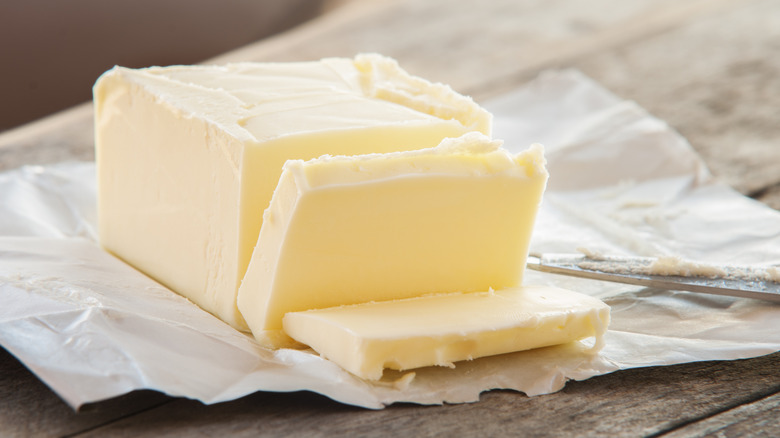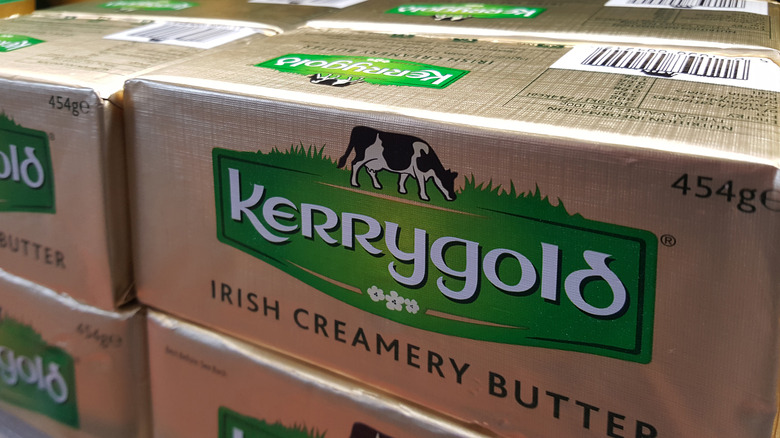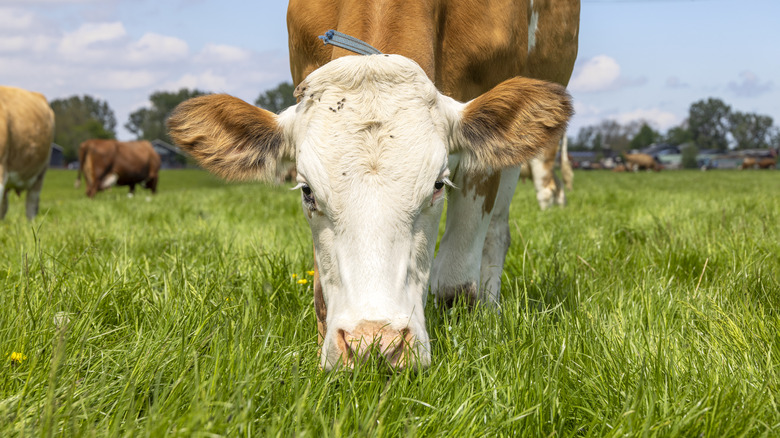The Costco Butter That Doubles As A Kerrygold Dupe
Kerrygold butter is among the best butter brands on the market. The Irish brand has garnered quite a cult following in the United States owing to its grass-fed nature, higher-than-average fat content, and delicious flavor. Yes, Kerrygold is a staple in kitchens across the United States, enhancing almost any recipe to which it is added. But Kerrygold also comes with an above-average price tag, which might discourage some cooks from reaching for the butter, even if its delicious flavor more than justifies the price.
But what if there was a less expensive dupe for that iconic yellow Irish butter? Well, there is. And if you're a Costco member you're in luck, because the wholesale retail club's Kirkland brand now has a grass-fed butter that might rival Kerrygold. Costco's Kirkland Signature Grass-fed Butter is 95% grass-fed and hails from New Zealand, which boasts some of the best dairy products in the world. All of this, and the butter comes in at a lower price point than Kerrygold, costing about one dollar less per pound.
The butter's grass-fed origin and lower price point have led many to call Kirkland Signature Grass-fed Butter a Kerrygold dupe. But does it deserve this title? Considering their shared grass-fed origins and identical fat content, the two butters are, on the surface level at least, comparable. And with a lower price point than Kerrygold, Kirkland's grass-fed butter seems to be a good dupe for the beloved Irish butter brand. But let's dig deeper into exactly how these two butters stack up against eachother.
How close is Kirkland to Kerrygold?
Let's start with the grass-fed claims. Kerrygold is perhaps best known for its grass-fed reputation. The brand's wrapping boasts that it comes from Irish grass-fed cows. Meanwhile, Kirkland's label promises that its butter comes from 95% grass-fed cows. No exact percentage is listed on the Kerrygold label, however, the brand did disclose that its cows are not fed entirely with grass, and that its cows' diets were supplemented with other grains. So neither butter is entirely grass-fed.
But beyond this, there are a few other points of comparison between the two butters. Kirkland's grass-fed butter has a lower salt content than Kerrygold's salted butter, which results in a slightly blander taste. In terms of butterfat content, Kerrygold has 82% butterfat, which is slightly higher than the 80% butterfat of most butters sold in the United States. According to its nutrition label, Kirkland's Grass-fed butter has the same fat content as Kerrygold.
Another difference between the two butters is their milk-solid content. In a video comparing the two butters, YouTuber AwareHouseChef determined that Kerrygold butter has more milk solids than Kirkland Grass-fed butter. This higher milk solid content can make Kerrygold better for browning, as milk solids are what gives brown butter its delicious, nutty taste. So the Kirkland brand isn't a direct dupe, but it can be a great choice for those hoping to cut down on grocery costs.
Meanwhile, the Costco connoisseurs of Reddit have their own thoughts on the matter. On r/Costco users gave their own input, with one user,Usernameistaken00, noting that "there are differences, but if you're just looking for generally good butter the Kirkland is the better buy." However, another Reddit user by the name of Setore was less kind to Kirkland, saying that they " ... tried the Kirkland butter but switched back to Kerrygold after the one pack." They noted a lack of taste as their main reason for switching back to Kerrygold, which seems to be the consensus among those who've tried both brands.
What a difference grass-fed makes
Perhaps the biggest tie between Kerrygold butter and Kirkland Brand Grass-fed butter is the fact that both butters come from grass-fed cows. But what makes grass-fed butter so special? For one, grass-fed butter has a distinct taste that sets it apart from regular butter. It tends to have a greener taste, while regular butter tends to have a sweet and creamy taste. Another difference is that grass-fed butter has a rich yellow color, whereas regular butter is white or a pale cream color. This color comes from beta-carotene, which is found in the grass eaten by grass-fed cows. The rich hue of grass-fed butter is appealing to many home cooks, making for a beautiful topper for many dishes, including a delicious a butter board, for example.
The difference between grass-fed butter doesn't just come down to taste and aesthetics, however. There are also some key nutritional difference between the two dairy products. Grass-fed butter also has high amounts of vitamin A, a nutrient that helps support both healthy vision and robust immune system. Grass-fed butter also contains omega-3 fatty acids, which can be beneficial for cardiovascular health. So that serving of grass-fed butter is more than just a tasty treat. It might just be a health conscious choice, whether you choose Kerrygold or Kirkland.


